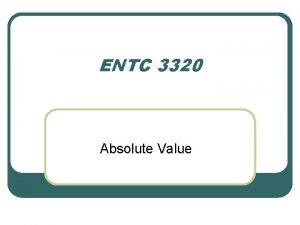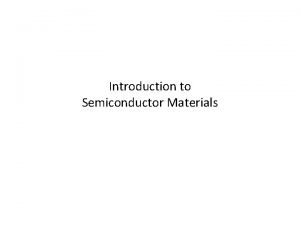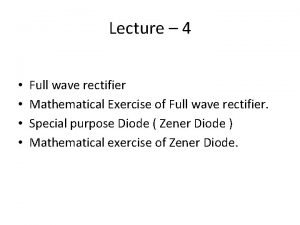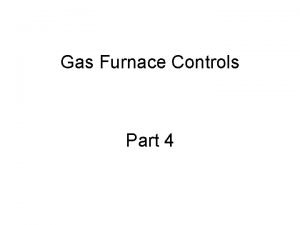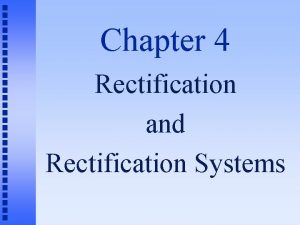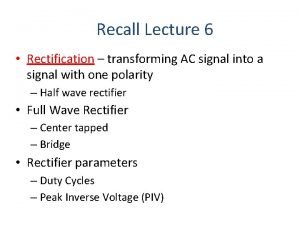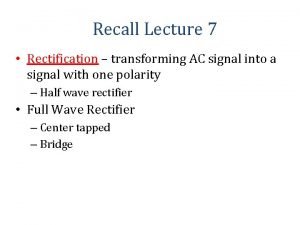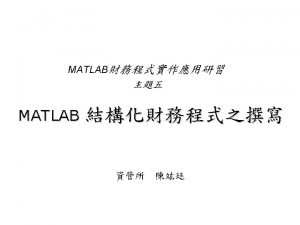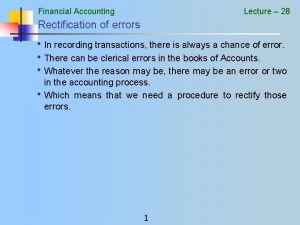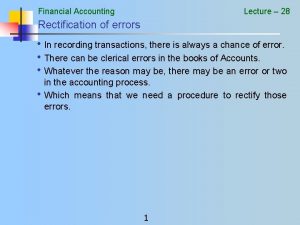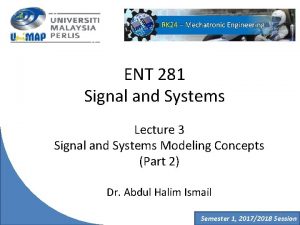Recall Lecture 6 Rectification transforming AC signal into

















- Slides: 17

Recall Lecture 6 • Rectification – transforming AC signal into a signal with one polarity – Half wave rectifier • Full Wave Rectifier – Center tapped – Bridge • Rectifier parameters – Duty Cycles – Peak Inverse Voltage (PIV)

Clipper Circuits

Standard Clipper Circuits ● Clipper circuits, also called limiter circuits, are used to eliminate portion of a signal that are above or below a specified level – clip value. ● The purpose of the diode is that when it is turn on, it provides the clip value i. Find the clip value = V’. To find V’, use KVL at L 1 assuming the diode is on ii. The equation is : V’ – VB - V = 0 V’ = VB + V VI V’ = VB + V L 1 iii. Then, set the conditions If VI > V’, what happens? diode conducts, clips and hence Vo = V’ If VI < V’, what happens? diode off, open circuit, no current flow, Vo = Vi

EXAMPLE For the circuit shown below sketch the waveform of the output voltage, Vo. The input voltage is a sine wave where VI = 5 sin t. VB is given as 1. 3 V. Assume V = 0. 6 V 1. 3 V

Solution i. Find the clip value = V’. To find V’, use KVL at L 1 assuming the diode is on ii. The equation is : V’ – 1. 3 - 0. 6= 0 V’ = 1. 9 V 1. 3 V iii. Then, set the conditions If Vin > V’, what happens? diode conducts, clips and hence Vo = V’ = 1. 9 V If Vin < V’, what happens? diode off, open circuit, no current flow, Vo = Vi VI V’ = 1. 9 V

EXAMPLE For the circuit shown below sketch the waveform of the output voltage, Vout. The input voltage is a sine wave where Vin = 10 sin t. Assume V = 0. 7 V + + Vin Vout - -

Solution i. Find the clip value = V’. To find V’, use KVL at L 1 assuming the diode is on ii. The equation is : V’ – 4 + 0. 7= 0 V’ = 3. 3 V iii. Then, set the conditions If Vin > V’, what happens? diode off, open circuit, no current flow, Vo = Vi If Vin < V’, what happens? diode conducts, clips and hence Vo = V’ = 3. 3 V VI V’ = 3. 3 V L 1

Parallel Based Clippers Ø Positive and negative clipping can be performed simultaneously by using a double limiter or a parallel-based clipper. Ø The parallel-based clipper is designed with two diodes and two voltage sources oriented in opposite directions. Ø This circuit is to allow clipping to occur during both cycles; negative and positive

Clipper in Series ECE 1201 The input signal is an 8 V p-p square wave. Assume, V = 0. 7 V. Sketch the output waveform, Vo. c b Initial stage: node a = 0 V Hence, node b = 1. 5 V So, node c of the diode must be at least 2. 2 V a

• Hence, the positive cycle of the square wave has met the condition of 2. 2 V • Perform KVL as usual: – 4 + 0. 7 + 1. 5 + Vo= 0 Vo = 1. 8 V 4 1. 8 -4

• What if now the input is change to 4 sin t? • It has to wait for the input signal to reach 2. 2 V. Before that, the output, Vo is zero as diode is off. • Perform KVL as usual: – 4 + 0. 7 + 1. 5 + Vo= 0 Vo = 1. 8 sin t V

Peak value is 1. 8 V

• So, basically, clipper in series clips at zero. It is similar to half wave where the diode only turns on during one of the cycle.

Clipper in Series Problem 3. 11 Figure P 3. 11(a) shows the input voltage of the circuit as shown in Figure P 3. 11(b). Plot the output voltage Vo of these circuits if V = 0. 7 V c P 3. 11(a) Initial stage: node a = 0 V Hence, node b = - 0. 7 V So, node c of the diode must be at least -1. 9 V b P 3. 11(b) a

• Hence, the negative cycle of the square wave has met the condition of |1. 9| V • Perform KVL as usual: + 3 - 0. 7 - 1. 2 + Vo= 0 Vo = - 1. 1 V vo 3 V + -1. 1

• What if now the input is change to 5 sin t ? • It has to wait for the input signal (negative cycle) to reach |1. 9| V. Before that, the output, Vo is zero as diode is off. • Perform KVL as usual: + 5 - 0. 7 - 1. 2 + Vo= 0 Vo = -3. 1 sin t V

Peak value is approximately -3. 1 V
 Rectification using a partially vaporized feed
Rectification using a partially vaporized feed X ray production
X ray production Flame rectification circuit
Flame rectification circuit Op amp absolute value
Op amp absolute value Shelf rectification and stock verification
Shelf rectification and stock verification Piv of centre tapped rectifier
Piv of centre tapped rectifier D'arsonval meter movement used with full-wave rectification
D'arsonval meter movement used with full-wave rectification Atomic structure of conductors
Atomic structure of conductors Full wave rectifier 4 diodes
Full wave rectifier 4 diodes Gas furnace sequence of operation flow chart
Gas furnace sequence of operation flow chart 01:640:244 lecture notes - lecture 15: plat, idah, farad
01:640:244 lecture notes - lecture 15: plat, idah, farad The product of two odd signals is:
The product of two odd signals is: Baseband signal and bandpass signal
Baseband signal and bandpass signal Baseband signal and bandpass signal
Baseband signal and bandpass signal Digital signal as a composite analog signal
Digital signal as a composite analog signal Transform data into information
Transform data into information Transforming data into information in computer
Transforming data into information in computer Product mapping
Product mapping



